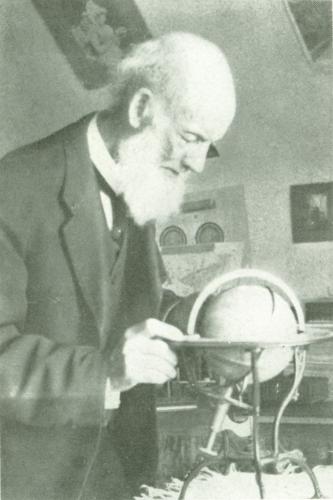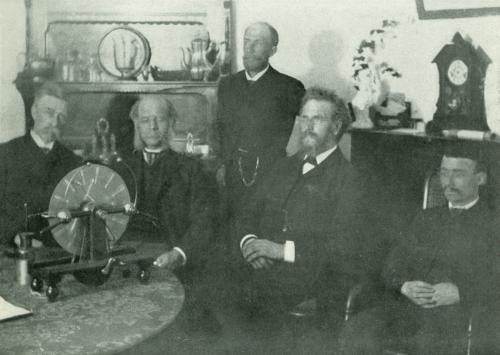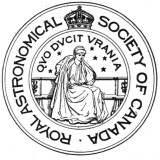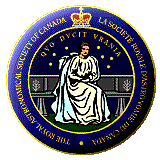The Origins & Evolution of the Royal Astronomical Society of Canada
Background
In the mid-nineteenth century, in the bustling Lake Ontario port city of Toronto, there were no professional astronomers. Many inhabitants of the city, however, were keenly interested in sciences and current developments in them. King's College, which grew into the University of Toronto, had been started in 1842. In 1849 it had 36 undergraduates attending, and had graduated a total of 55 students in the three faculties of arts, law and medicine. The Toronto Magnetic Observatory had been established in 1840. Its early directors and observers were officers and soldiers in garrison. Some of them, such as Captain J.F. Lefroy, contributed much to the cultural life of the city. Out of this body of interest came the Canadian Institute established in 1849 “to promote those pursuits which are calculated to refine and exalt a people.”
 Besides holding weekly meetings, the Canadian Institute accumulated an outstanding library. There many hours were spent in study by Andrew Elvins who had come to Canada from Cornwall in 1844. In 1860 he moved to Toronto, with a population then of 44,000, and became chief cutter in a well known clothing store on King Street. While the Canadian Institute held discussion meetings of all sciences, Elvins wished to concentrate on astronomy. For this purpose he gathered together a few like-minded friends.
Besides holding weekly meetings, the Canadian Institute accumulated an outstanding library. There many hours were spent in study by Andrew Elvins who had come to Canada from Cornwall in 1844. In 1860 he moved to Toronto, with a population then of 44,000, and became chief cutter in a well known clothing store on King Street. While the Canadian Institute held discussion meetings of all sciences, Elvins wished to concentrate on astronomy. For this purpose he gathered together a few like-minded friends.
Founding
On December 1, 1868 The Toronto Astronomical Club met for the first time, at the Mechanics' Institute (formerly at Adelaide and Church), “having for its object the aiding of each other in the pursuit of astronomical knowledge.” The thousands of meteor sightings of the Leonid showers made in Toronto in November 1867 and 1868 had doubtless encouraged the project. In May, 1869 the word “Club” was changed to “Society.” Written records were kept for the first year, until the secretary moved away. The last recorded “official” meeting was in early December of 1869, with only four members in attendance. After that, the Toronto Astronomical Society seems to have moved into the shadows, leaving few if any documentary traces of activity. Elvins1 attempted to keep interest alive through hosting meetings in his house, and eventually the Recreative Science Association (1879) was formed, which numbered former Toronto Astronomical Club members among its ranks. Astronomy was one of the objects of its meetings, but certainly not the most significant. An association—perhaps even an amalgamation—with the Natural History Society of Toronto followed.
Incorporation
 As the century wore on, Elvins the tailor, who lived till 1918, acquired more kindred spirits, some of them influential and prominent. A.F. Miller, a leading hospital administrator and colleague of Elvins, recorded that in the early 1880s “a small party of amateurs met occasionally, from house to house, to discuss scientific matters and papers under Mr. Elvins leadership.” The 1882 transit of Venus played some role in bringing amateurs together (it is how Elvins and Miller met). In 1884 The Astronomical and Physical Society of Toronto was formed, which can be considered a reconstitution of The Toronto Astronomical Club of 1868-1869. On March 10, 1890, the organization was incorporated as The Astronomical and Physical Society of Toronto (incidentally, the year the British Astronomical Association was founded). Its first president was a government scientist, Charles Carpmael, director of the Meteorological Observatory, and president of the Royal Canadian Institute. From that time till developments in the 1970s it was the Canadian organization of astronomers, with a dual membership of professionals and amateurs.
As the century wore on, Elvins the tailor, who lived till 1918, acquired more kindred spirits, some of them influential and prominent. A.F. Miller, a leading hospital administrator and colleague of Elvins, recorded that in the early 1880s “a small party of amateurs met occasionally, from house to house, to discuss scientific matters and papers under Mr. Elvins leadership.” The 1882 transit of Venus played some role in bringing amateurs together (it is how Elvins and Miller met). In 1884 The Astronomical and Physical Society of Toronto was formed, which can be considered a reconstitution of The Toronto Astronomical Club of 1868-1869. On March 10, 1890, the organization was incorporated as The Astronomical and Physical Society of Toronto (incidentally, the year the British Astronomical Association was founded). Its first president was a government scientist, Charles Carpmael, director of the Meteorological Observatory, and president of the Royal Canadian Institute. From that time till developments in the 1970s it was the Canadian organization of astronomers, with a dual membership of professionals and amateurs.
Name Changes
In May, 1900, chiefly through the efforts of one of the important early members George E. Lumsden, another of Elvins' friends, and a provincial deputy minister, the name was changed to The Toronto Astronomical Society (tradition holds that Mrs. Lumsden's Victorian propriety was offended by the word “physical”, as it could refer to the body!). In early 1903, the King of the Dominion, Edward VII of England, was petitioned through official channels to allow the Society to adopt the “Royal” style. On the 27th of February the Society was informed that “His Majesty the King has been graciously pleased to grant permission to the Toronto Astronomical Society to adopt the title of the Royal Astronomical Society of Canada” (the change was enacted in a provincial court on March 3, 1903). We have been known by that name ever since. For many years (1909-46) the Society had its offices and library in the Royal Canadian Institute buildings, and held meetings there as well as at the nearby Sandford Fleming Building on the campus of the University of Toronto.
Publications
 Early in the 1890’s, Dr. Clarence A. Chant of the University of Toronto became deeply interested in the Society. Dr. Chant's forte was not research, but he was an effective organizer and impresario of sorts for Canadian astronomy. Much of the direction he gave to the RASC until his death in 1956 still lingers. During its first fifteen years the Society published annually volumes containing its Transactions and Annual Report. In 1907 Dr. Chant started The Journal of the Royal Astronomical Society of Canada, and the Observer's Handbook, called then “The Canadian Astronomical Handbook.” It is a remarkable fact that at the time of his death Dr. Chant had been the Editor of both the Journal and the Handbook for exactly 50 years. During this period he received generous assistance from many of the Society’s members. At times the Journal was published monthly, but currently it is bi-monthly.
Early in the 1890’s, Dr. Clarence A. Chant of the University of Toronto became deeply interested in the Society. Dr. Chant's forte was not research, but he was an effective organizer and impresario of sorts for Canadian astronomy. Much of the direction he gave to the RASC until his death in 1956 still lingers. During its first fifteen years the Society published annually volumes containing its Transactions and Annual Report. In 1907 Dr. Chant started The Journal of the Royal Astronomical Society of Canada, and the Observer's Handbook, called then “The Canadian Astronomical Handbook.” It is a remarkable fact that at the time of his death Dr. Chant had been the Editor of both the Journal and the Handbook for exactly 50 years. During this period he received generous assistance from many of the Society’s members. At times the Journal was published monthly, but currently it is bi-monthly.
Expansion
 The change of name in 1903 led immediately to the concept that the Society should not be limited to Toronto, but should become national in scope. The second Centre to be established was that of Ottawa in 1906, where the Dominion Observatory was being set up. In Ottawa W.F. King, Carlyle S. Beals, and Peter M. Millman along with equally notable collaborators made major contributions to professional astronomy, and the Society. The other early regional RASC node with a strong commitment to research and leading professional involvement was Victoria Centre, thanks to J.S. Plaskett, Andrew McKellar, R.M. Petrie, and colleagues.
The change of name in 1903 led immediately to the concept that the Society should not be limited to Toronto, but should become national in scope. The second Centre to be established was that of Ottawa in 1906, where the Dominion Observatory was being set up. In Ottawa W.F. King, Carlyle S. Beals, and Peter M. Millman along with equally notable collaborators made major contributions to professional astronomy, and the Society. The other early regional RASC node with a strong commitment to research and leading professional involvement was Victoria Centre, thanks to J.S. Plaskett, Andrew McKellar, R.M. Petrie, and colleagues.
Pro-Am Cooperation
Outstanding amateur members have made their mark on astronomy, and contributed to making the RASC more than just an astronomy club, among them David H. Levy, Paul Boltwood, and Damien Lemay, among many others.
As mentioned earlier, the close involvement of professionals in the Society and their provision of leadership changed with the rise of the Canadian Astronomical Society/Société Canadienne d’Astronomie (CASCA), during the long decade 1971-1983. CASCA is the voice of professional astronomy in Canada, and its Board of Directors forms the Canadian National Committee of the International Astronomical Union (IAU). Due to the changing nature of how cutting-edge astronomy was done nationally, and internationally in the 1970s, and the changing demands of securing big money for big science, the creation of a Canadian professional society was inevitable and necessary for the health of the discipline. Relations between RASC and CASCA remain cordial and cooperative, but the fact that professional involvement in the older Society has progressively and dramatically declined since 1971 has not been entirely to the good. Fortunately, some professionals are still members, and contribute significantly, such as James Hesser, John R. Percy, Douglas P. Hube, Doug Welch, Roberto Abraham, and Mike Reid, to name a few.
 Epilogue
Epilogue
With 29 Centres from sea to sea across Canada, and well-over 4000 members, the Society has the potential to be significant within the scientific fabric of the country. Furthering science literacy is both noble, and essential. As the Astronomer Royal, Lord Rees of Ludlow, has remarked:
Certainly it should be possible, in my opinion, to make the essence of science accessible to people in plain English. The technical details involve mathematics and formulae...but the essence I think can be explained in plain English to the extent that is needed by a citizen to make an informed decision [second Reith Lecture for 2010].
With luck and discernment it is to be hoped that the Society can summon the vision to remain useful to our fellow citizens in the coming years.
—Helen Sawyer Hogg, Walter MacDonald, and R.A. Rosenfeld
Footnote
- According to Elvins, at no time from 1868 on, did the Society entirely disappear: "There were times when the Toronto Astronomical Society was not a very vigorous insitution...Mr. Elvins assures me, however, and his accuracy is confirmed by others who have knowledge of the facts in the case, that the meetings of [the Society] have never been discontinued at any time since their inception in 1868"; A.D. Watson, "Astronomy in Canada", JRASC 11, 2 (1917 February), 46-78, at p. 58.
